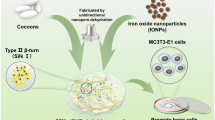Abstract
A simplified method to modify electrospun PCL fibers for better degradation and cytocompatibility is proposed. The surface modification was achieved by preparing fibers having pores and subsequent alkali treatment. The modifications were studied by comparing hydrolyzed PCL mats, porous PCL mats and hydrolyzed porous PCL mats with unmodified PCL mats. The in vitro degradation analyzed in simulated wound fluid and biological response using L-929 cells confirmed surface-hydrolyzed porous PCL fibers as non-cytotoxic with enhanced cell adhesion, viability and degradability. The proposed modification will be suitable to fabricate implantable electrospun scaffolds.








Similar content being viewed by others
References
Labet M, Thielemans W (2009) Synthesis of polycaprolactone: a review. Chem Soc Rev 38:3484
Chavalitpanya K, Phattanarudee S (2013) In: 10th Eco-energy and materials science and engineering symposium. 34, p 542
Woodruff MA, Hutmacher DW (2010) Prog Polym Sci 35:1217
Pham QP, Sharma U, Mikos AG (2006) Electrospinning of polymeric nanofibers for tissue engineering applications: a review. Tissue Eng 12:1197
Cipitria A, Skelton A, Dargaville TR, Dalton PD, Hutmacher DW (2011) Effect of different solvents on poly (caprolactone)(PCL) electrospun nonwoven membranes. J Mater Chem 21:9419
Qin X, Wu D (2012) J Therm Anal Calorim 107:1007
Li WJ, Laurencin CT, Caterson EJ, Tuan RS, Ko FK (2002) Electrospun nanofibrous structure: a novel scaffold for tissue engineering. J Biomed Mater Res 60:613
Subbiah T, Bhat GS, Tock RW, Pararneswaran S, Ramkumar SS (2005) Electrospinning of nanofibers. J Appl Polym Sci 96:557
Ng KW, Achuth HN, Moochhala S, Lim TC, Hutmacher DW (2007) In vivo evaluation of an ultra-thin polycaprolactone film as a wound dressing. J Biomater Sci-Polym Ed 18:925
Williams JM, Adewunmi A, Schek RM, Flanagan CL, Krebsbach PH, Feinberg SE, Hollister SJ, Das S (2005) Bone tissue engineering using polycaprolactone scaffolds fabricated via selective laser sintering. Biomaterials 26:4817
Yeong WY, Sudarmadji N, Yu HY, Chua CK, Leong KF, Venkatraman SS, Boey YC, Tan LP (2010) Porous polycaprolactone scaffold for cardiac tissue engineering fabricated by selective laser sintering. Acta Biomater 6:2028
Chen H, Huanga J, Yu J, Liu S, Gu P (2011) Electrospun chitosan-graft-poly (ɛ-caprolactone)/poly (ɛ-caprolactone) cationic nanofibrous mats as potential scaffolds for skin tissue engineering. Int J Biol Macromol 48:13
Wong DJ, Chang HY (2009) Skin tissue engineering. In: StemBook [Internet]. Harvard Stem Cell Institute, Cambridge. https://doi.org/10.3824/stembook.1.44.1
Wharram SE, Zhang XH, Kaplan DL, McCarthy SP (2010) Electrospun silk material systems for wound healing. Macromol Biosci 10:246
Agarwal S, Wendorff JH, Greiner A (2008) Use of electrospinning technique for biomedical applications. Polymer 49:5603
Prasad T, Shabeena EA, Vinod D, Kumary TV, Anil Kumar PR (2015) Characterization and in vitro evaluation of electrospun chitosan/polycaprolactone blend fibrous mat for skin tissue engineering. J Mater Sci Mater Med 26:5352
Katsogiannis KAG, Vladisavljević GT, Georgiadou S (2015) Porous electrospun polycaprolactone (PCL) fibres by phase separation. Eur Polymer J 69:284
Pant HR, Neupane MP, Pant B, Panthi G, Oh HJ, Lee MH, Kim HY (2011) Fabrication of highly porous poly (ɛ-caprolactone) fibers for novel tissue scaffold via water-bath electrospinning. Colloids Surf B Biointerf 88:587
Yan D, Jones J, Yuan XY, Xu XH, Sheng J, Lee JC, Ma GQ, Yu QS (2013) Plasma treatment of electrospun PCL random nanofiber meshes (NFMs) for biological property improvement. J Biomed Mater Res A 101:963
Bassi AK, Gough JE, Zakikhani M, Downes S (2011) The chemical and physical properties of poly(ε-caprolactone) scaffolds functionalised with poly(vinyl phosphonic acid-co-acrylic acid). J Tissue Eng 2011:615328
Han N, Johnson JK, Bradley PA, Parikh KS, Lannutti JJ, Winter JO (2012) Cell attachment to hydrogel-electrospun fiber mat composite materials. J Funct Biomater 3:497
Sant S, Hwang CM, Lee S-H, Khademhosseini A (2011) Hybrid PGS–PCL microfibrous scaffolds with improved mechanical and biological properties. J Tissue Eng Regen Med 5:283
Dayal P, Liu J, Kumar S, Kyu T (2007) Experimental and theoretical investigations of porous structure formation in electrospun fibers. Macromolecules 40:7689
Getnet M, Chavan R (2015) Catalyzation of alkaline hydrolysis of polyester by oxidizing agents for surface modification. Int J Sci Basic Appl Res 22:232
Suwantong O (2016) Biomedical applications of electrospun polycaprolactone fiber mats. Polym Adv Technol 27:1264
Bolgen N, Menceloglu YZ, Acatay K, Vargel I, Piskin E (2005) In vitro and in vivo degradation of non-woven materials made of poly (ε-caprolactone) nanofibers prepared by electrospinning under different conditions. J Biomater Sci Polym Ed 16:1537
Augustine R, Thomas S, Kalarikkal N (2014) Effect of zinc oxide nanoparticles on the in vitro degradation of electrospun polycaprolactone membranes in simulated body fluid. Int J Inst Mater Malays 2:211
Mijovic B, Trcin MT, Agic A, Zdraveva E, Bujic M, Spoljaric I, Kosec V (2012) Recent progress in tissue engineering and regenerative medicine. J Fiber Bioeng Inform 5:33
Acknowledgements
The authors acknowledge the financial support from the Department of Science and Technology, Grant number SR/FT/LS-128/2009 to AKPR. The authors thank Ms. Nimi N for contact angle measurements and Mr. Nishad for scanning electron microscopy analysis.
Author information
Authors and Affiliations
Corresponding author
Rights and permissions
About this article
Cite this article
Bhaskaran, A., Prasad, T., Kumary, T.V. et al. Simple and efficient approach for improved cytocompatibility and faster degradation of electrospun polycaprolactone fibers. Polym. Bull. 76, 1333–1347 (2019). https://doi.org/10.1007/s00289-018-2442-7
Received:
Revised:
Accepted:
Published:
Issue Date:
DOI: https://doi.org/10.1007/s00289-018-2442-7




